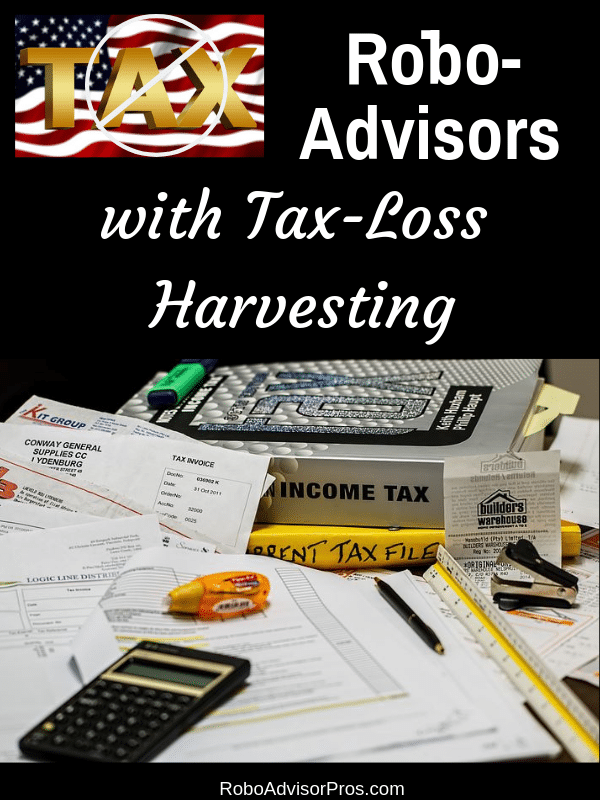Tax-loss harvesting is mentioned a lot in the conversation about robo-advisors, since many offer this feature. Robo’s such as Betterment and Empower tout it as a way to increase your after tax return.
And who doesn’t want higher returns?
Often, though, tax-loss harvesting takes a backseat to other key robo-advisor features, such as low monthly fees, flexible portfolios, and socially responsible investing options. Although these features are important considerations when selecting your robo-advisor, tax-loss harvesting shouldn’t be overlooked.
Understanding tax-loss harvesting, as well as whether you need it in your robo-advisor, is key to making a good investing decision.
[toc]
*Disclosure: Please note that this article may contain affiliate links which means that – at zero cost to you – I might earn a commission if you sign up or buy through the affiliate link.
What is Tax-Loss Harvesting?
Tax-loss harvesting is a way to minimize the tax impact of capital gains. Since robo-advisors are run by algorithms, the programs can easily identify assets with unrealized losses and sell them. Then the losses can be used to offset the taxable gains, and reduce overall tax payments.
Robo-advisor tax-loss harvesting enables investors to reduce the amount of taxes they pay on their gains. Next, the robos will replace the tax-harvested loss with a similar asset, so your asset allocation remains aligned, while ensuring compliance with the wash sale rule.
Buying a similar, but not identical asset avoids the wash sale rule, which disallows buying back the same security within 30 days of a sale.
Tax-loss harvesting only applies to taxable accounts, not retirement accounts like Traditional, Roth, 401k or 403b accounts.
How Robo-Advisor Tax-Loss Harvesting Works
The computerized algorithm is programmed to complete this process in a taxable brokerage account.
- There are two types of losses (and gains), short term – for investments held for one year or less, and long term – for investments owned for more than a year.
- To reduce taxes, investments that declined in value are sold.
- First, the short term losses are deducted from any short term gains.
- Next, the long term losses are deducted from any long-term gains.
- If any losses remain, they can be used to offset any type of gain and vice versa.
- You can deduct up to $3,000 per year against other types of income. Any additional losses can be carried over into future years.
“Net losses of either type can then be deducted against the other kind of gain. So, for example, if you have $2,000 of short-term loss and only $1,000 of short-term gain, the net $1,000 short-term loss can be deducted against your net long-term gain (assuming you have one). If you have an overall net capital loss for the year, you can deduct up to $3,000 of that loss against other kinds of income, including your salary and interest income, for example. ” ~Turbo Tax
For example, if the robo advisor has you have $5,000 in short-term losses and only $1,000 of short-term gains. The remaining $1,000 short term loss can be deducted against your net long-term gain or other income.
Tax loss harvesting is a good opportunity to remove losing positions and potentially increase net investment returns. And robo-advisors are uniquely qualified to automate this process. In fact Wealthfront claims that their tax-loss harvesting, might compensate for their 0.25% AUM advisory fee.
Yet, tax-loss harvesting is only for taxable investment accounts, not retirement accounts like IRA’s or 401(k)’s. That’s because in retirement accounts, taxes are deferred until you withdraw your funds, for traditional IRA’s and 401(k) accounts. While most Roth IRA’s, are funded with after tax contributions and withdrawals are then tax-free.
Which Robo-Advisors Offer Tax-Loss Harvesting?
7 Robo-advisors With Tax-loss Harvesting
1. Betterment
Betterment offers tax-loss harvesting for both Digital and Premium clients. Betterment Digital has no minimum balance, but requires $10 to begin investing. Betterment Digital charges of 0.25% AUM for accounts worth more than $20,000 or those with an auto deposit of at least $250 per month. Accounts worth less than $20,000 pay $4 per month. Investors with a higher balance can access Betterment Premium with a $100,000 minimum investment and a management fee of 0.40% AUM. Betterment Premium clients receive access to financial advisors. Customized portfolios including ESG and crypto are also available.
2. Empower
Empower has free investing and finance management tools available. Anyone can use the retirement and investment management tools for free, but only paid users will get access to tax-loss harvesting. Paid accounts require a $100,000 minimum balance for complete financial planning services, comparable with a Traditional financial planner. Fees start at 0.89% AUM and gradually decrease in increments until they reach 0.49% AUM for accounts valued over $10 million.
3. Schwab Intelligent Portfolios
Schwab offers tax-loss harvesting for taxable accounts with values over $50,000. To open an account, investors will need a $5,000 minimum investment. Schwab doesn’t charge investment management fees but require an 8% to 10% cash allocation in each portfolio. Investors who want financial advisory guidance will like the premium Schwab Intelligent Portfolios Premium with low subscription pricing.
4. Wealthfront
Wealthfront offers tax-loss harvesting on all taxable accounts. Wealthfront also has a low $500 minimum investment requirement and a management fee of 0.25% AUM. There’s a free cash promo, if you sign up with the link below. Wealthfront also recently added crypto and more than 200 ETFs for customized portfolios. They also have fee-free stock and ETF trading.
5. Axos Invest
Axos Invest, is a low-fee robo-advisor with tax-loss harvesting for 0.24% AUM. Axos Invest has no investment minimum. The platform also offers the opportunity for customization with a list of additional ETFs.
6. Vanguard Robo-Advisors
Vanguard offers an all digital robo-advisor and the Personal Advisor Services choice with financial advisors. Tax-loss harvesting is implemented on a case-by-case basis only. The Digital offer charges 0.15% AUM and requires a $3,000 minimum. While the Personal Advisor Services requires a $50,000 minimum and charges a 0.30% AUM fee.
7. Future Advisor
Future Advisor – Recently acquired by Ritholtz, Blackrock’s robo-advisor offers tax loss harvesting and will manage your investments while they remain in your TD Ameritrade and Fidelity accounts. The premium account requires a $5,000 minimum and charges 0.50% AUM management fee. Although, all customers have access to live financial advice.
Which Robo-Advisor Offers Tax Minimization?
Some robo-advisors don’t offer tax-loss harvesting, but all robo-advisors are designed to help you make the most of your investments. For that reason, Ellevest, offers tax minimization strategies that help you minimize losses and increase your earnings.
“But tax loss harvesting is only a temporary fix for lowering taxes; you may save some money on taxes now, but you’re just deferring them,” Ellevest website.
- Ellevest, the robo-advisor for women, offers tax minimization through tax-deferred accounts and tax-efficient municipal bonds, among other strategies. Ellevest has no minimum required balance. Reasonably priced subscription fees range from $1 to $9 per month with increasing service levels. All investors have access to discounted financial and career advisory services.
What are the Pros and Cons of Tax-Loss Harvesting?
So far tax-loss harvesting sounds like a great way to pay less in taxes, right?
Yet, there are tax-loss harvesting pros and cons you should be aware of before jumping headfirst into tax-loss harvesting as an investing strategy.
Tax-Loss Harvesting Advantages
- You can lower your tax bill. This is the greatest benefit to tax-loss harvesting, especially when a robo-advisor can do the calculations and rebalancing for you.
- Many robo-advisors complete the calculations for you. Not all robo-advisors will do tax-loss harvesting and others offer harvesting only for higher-paying clients, so if you’re facing a difficult decision as to whether or not to use a tax-loss harvesting strategy it might be worthwhile to pick a robo with this feature.
- Tax-loss harvesting keeps you on track with your portfolio. Although there are always dips in the market, sometimes selling, even if only momentarily, is the best option for your portfolio. Strategically cutting your losses can make your portfolio stronger.
Tax-Loss Harvesting Disadvantages
- The Wash Sale Rule prevents you from repurchasing the same investment or a substantially similar one within 30 days after the sale. If you want to stay investing in the identical asset, this approach won’t work for you.
- You might miss out on potential gains. There’s always the risk that the stock you sell off at a loss will suddenly grow again, so paying attention to the industries or companies you are investing in is key.
- It’s a lot of work. If your robo-advisor or personal financial advisor isn’t doing the calculations for you, this process might require entirely too much juggling to make it worthwhile.
- Transaction fees still apply for all trades and sales, unless otherwise stated with your advisor (robo or human). Check the fine print to make sure all this movement in your portfolio is good for your long-term goals.
The Takeaway: Robo-Advisors and Tax-Loss Harvesting
Tax-loss harvesting can be a good way to limit the amount of taxes you will pay on realized gains. Performing tax-loss harvesting on your own can be a bit complicated. Letting a digital investment manager do it for you makes the process much easier.
Even if tax-loss harvesting isn’t the right strategy for your investments, many robo-advisors offer other tax minimization strategies, like ading municipal bonds to your taxable accounts, to help you meet your financial goals.
Related
Differences Between Robo-Advisors
Best Robo-Advisors For High Net Worth Investors
Disclosure: Please note that this article may contain affiliate links which means that – at zero cost to you – I might earn a commission if you sign up or buy through the affiliate link. That said, I never recommend anything I don’t believe is valuable
Empower compensates Stocktrades Ltd (“Company”) for new leads. Stocktrades Ltd is not an investment client of Empower.


